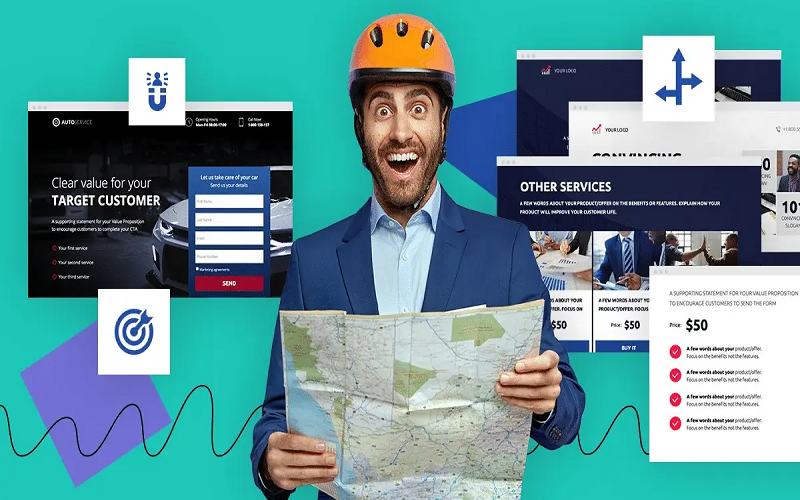A landing page is a single web page of an Internet business which is the first introductory point between a visitor and the business. It has an even greater influence on the ways that the visitors view that site and whether or not they perform the sought-after action of buying a product, subscribing to a publication, or requesting additional information. Thus, in the sphere of online marketing, success greatly depends on the success rate of the website landing page Through the optimization of important features that improve user experience and promote conversions, organizations may improve the results of their landing pages.
A simple and captivating headline
The headline is the first thing a user sees when they look at a website. It must be succinct,captivating, and clear to get their attention right away. A compelling title persuades readers to stay on the landing page and learn more by conveying its main point. It ought to convey the value proposition and establish the general tone for the page’s content.
Interesting and Pertinent Content
A landing page’s content ought to be pertinent to the requirements and interests of the visitor. It should offer insightful information consistent with the page’s main goal and headline. Interesting material keeps readers interested and entices them to look around further. While it requires the writer to use short sentences and many headings that would help to divide a piece of information, the content’s structure must also be simple.
Target Call to Action (CTA)
But, due to the distractions on the internet, the website visitors have to be guided towards the activity that is intended to be performed and that can be possible only through a favorable call to action. The CTA has to be clear, brief and noticeable when a person is filling out a form, clicking a button or executing a transaction. The wording of the CTA should make people act now; thus, it should include a sense of urgency or importance. The position of the CTA is also rather critical; it must be easily found and within eyesight, preferably in the above-the-fold category.
Design and Aesthetic Appeal
Any landing page contains several visual elements and it has a significant impact on the performance of the tool. The page has more visual appeal and gains trust when it is designed neatly and professionally. A unified look and feel should be produced by using images, typefaces, and colors that complement the brand’s identity. Superior photographs or videos can enhance the message’s effectiveness and emotionally connect viewers. The total user experience should be improved and complemented by the design, not overshadowed by it.
The responsiveness of mobile
It is also crucial since most people use their mobile devices for surfing the Internet to check websites, use applications, etc. The mobile responsiveness of the layout ensures that the website functions optimally and is visually attractive, whether accessed through tablets or smartphones. Mobile responsiveness is one of the most important factors influencing conversion rates since it makes the page easily navigable on a device thus making the visitor take the desired action.
Quick Loading Speed
It turns out that both SEO and UX both rely heavily on how fast the pages in question are. Late loading of a landing page is also a sure way of seeing users fleeing away from the page in a process known as bouncing. It is common knowledge that landing pages take only a few seconds to load, to afford a good user experience. To accomplish this, there could be the utilization of good coding methods, less use of big files and optimization of photos.
Assurance Markers
A few of the trust indications include certificates, security badges, reviews and overall customer testimonials and these would significantly improve the legitimacy of a landing page. Even if the visitors have faith in the company/brand, they only will act. The landing page’s inclusion of these components reassures visitors that they are making a wise and secure choice.
Optimizing Through A/B Testing
One effective method for landing page optimization is A/B testing. Businesses can test many iterations of a landing page to see which components work best and make data-driven adjustments to increase the page’s efficacy. Changing the page’s headline, call to action, pictures, or any other component can all be done as part of A/B testing to evaluate which version performs better. A high-performing landing page requires constant testing and tweaking.
Continual Branding
Visitors’ trust in the brand is increased and brand identification is reinforced when landing page branding is consistent. This involves using typefaces, colors, logos, and voiceovers that complement the overall brand image. Maintaining consistency makes the landing page seem like a logical continuation of the brand and gives users a unified experience.
Social Evidence
One important factor that has the ability to affect visitor behavior is social proof. Credibility and trust can be increased by using components like case studies, social media mentions, and client testimonials. Visitors are more inclined to take the intended action when they discover that other customers have had favorable experiences with the good or service. Social evidence reassures and can be a powerful conversion motivation.
Individualization
Customization has the potential to greatly increase a landing page’s efficacy. A more relevant and interesting experience can be produced by customizing the offers and content to the visitor’s unique requirements and preferences. Dynamic content that adapts to visitor behavior, geography, and other variables can help achieve this. Customization improves conversion rates by fostering a relationship with the visitor.
Analytics and Monitoring of Performance
For continuous optimization, tracking a landing page’s effectiveness is crucial. Businesses can keep an eye on important data like user behavior, conversion rates, and bounce rates by utilizing analytics tools. This information offers insightful information about how users engage with the page and areas for improvement. Businesses may increase the efficacy of their landing pages and make well-informed decisions by routinely evaluating and analyzing

